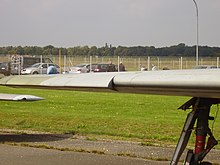Sägezahn (Aerodynamik)

Ein Sägezahn ist in der Aerodynamik eine aerodynamische Baugruppe am Flügel oder Leitwerkflächen, welche die Strömung vor allem über den Außenbereichen bei hohen Anstellwinkeln beeinflusst. Die Bezeichnung kommt von der gezackten (zahnartigen) Gestaltung der Vorderkante.
Wirkungsweise
Beim Flug mit hohen Anstellwinkeln löst sich an Flügeln kleiner Streckung im Außenbereich die Strömung ab. Dies führt zu Verlust von aerodynamischem Auftrieb und Wirksamkeit der Steuerflächen. Um die äußere Strömung zu stabilisieren, wird über den so genannten Sägezahn an der Vorderkante ein neuer (Vorderkanten-)Wirbel erzeugt. Dieser bringt zusätzliche Energie in die sich ablösende Strömung und stabilisiert sie dadurch. Das Flugzeug kann höhere Anstellwinkel erfliegen und hat bessere Manövriereigenschaften in diesem Flugbereich.
Sägezähne finden sich vor allem bei älteren Flugzeugen.
Weitere Möglichkeiten
Neben Sägezähnen bestehen weitere Möglichkeiten, die Strömung über der Tragfläche, vor allem über dem Außenbereich, zu stabilisieren:
Beispiele
- Verschiedene Flugzeugtypen mit Sägezähnen in der aerodynamischen Auslegung
Auf dieser Seite verwendete Medien
Luftwaffenmuseum der Bundeswehr; Airforce Museum of the Bundeswehr; Berlin-Gatow, F.Mk.6
This photo shows the F-8 Digital-Fly-By Wire aircraft in flight. The project involving this aircraft contributed significantly to the flight control system on the space shuttles by testing and getting the bugs out of the IBM AP-101 used on the shuttles and by helping the Dryden Flight Research Center to develop a pilot-induced oscillation (PIO) suppression filter that reduced the likelihood of pilots overcontrolling the shuttles on landings and thereby creating excursions from the intended landing path.
U.S. Navy A-6E Intruder (Bu No 155592) using a belly mounted 'buddy' pack, performs in-flight refueling with a French Navy Super Etendard (right) while operating in the western Mediterranean Sea, June 19, 1996. The Intruder was flying from the deck of the aircraft carrier USS George Washington (CVN 73), while the Super Etendards were operating from the French aircraft carrier Clemenceau (R 98). The two carriers and their aircraft used the opportunity to practiced underway replenishment and in-flight refueling respectively. The Intruder is attached to Attack Squadron 34 'Blue Blasters', of Naval Air Station Oceana, Virginia USA.
A U.S. Navy Ling-Temco-Vought A-7E-8-CV Corsair II (BuNo 157581) of Attack Squadron 12 (VA-12) "Flying Ubangis" in flight, circa in 1979. VA-12 was assigned to Carrier Air Wing 7 (CVW-7) aboard the aircraft carrier USS Dwight D. Eisenhower (CVN-69) for a deployment to the Mediterreanean Sea from 16 January to 13 July 1979.
Note: The date given (16 April 1987) has to be incorrect, as VA-12 was disestablished on 1 October 1986. Due to the paint scheme the photo was taken in the 1970s. The pilot (LCDR Rick Brydges), mentioned below the canopy, was assigned to VA-12 in 1979.
An F-4G Phantom II aircraft shows its undercarriage holding four different missiles: one each AGM-45, AGM-65, AGM-78, and AGM-88.












